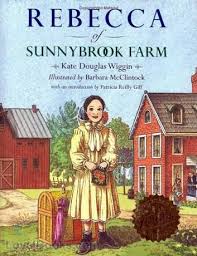Kate Douglas Wiggin
Listen to the Recess! Clip
| Author | Rita Smith |
| Air Date | 9/27/2001 |

Kate Douglas Wiggin Transcript
Toward the end of her life, Kate Douglas Wiggin was named by the San Francisco Examiner as one of the six most distinguished women in the world. She had distinguished herself in two ways: first as a woman who gave many years of service to the kindergarten movement, and second, as a writer of books for children.
As a child, although, of course, unaware of it, she practiced for both careers. She prepared for her teaching by conducting a singing school for frogs in the idyllic rural area of Maine where she spent her childhood, and in preparation for her career as a writer, she read widely, including books written for adults, such as Uncle Tom’s Cabin, and the tales of Charles Dickens. She loved Dickens and named her animals and toys after his characters, giving her sled the hopeful name of The Artful Dodger.1 Her first publication came at age 20 when St. Nicholas Magazine for Boys and Girls accepted a story and paid her $150. She was delighted and produced another story for St. Nicholas about the exploits of a group of New England girls in which she created two of her most famous characters, Aunt Miranda and Aunt Jane, the memorable aunts which appear in her later book, Rebecca of Sunnybrook Farm.2
She spent the first years of her working life teaching kindergarten and campaigning on behalf of the fledgling kindergarten movement, but with the modest success of her first two books in 1889 and 1891, she turned her attention to writing fiction for children.
Many of Wiggin’s books for children are in the sentimental 19th century style, with child characters who are saintly and sick, but the main character of her best known work of fiction, Rebecca Rowena Randall, doesn’t fit this mold at all. In fact, one critic notes that the most memorable aspect of this book is Rebecca herself, “full of life, intelligent, imaginative, free spirited, impulsive, generous.3” and happy. Yet Rebecca’s happiness is tempered with life’s realities of relative poverty, duty, hard work and self sacrifice, realities Wiggins herself understood from her years of working with children. Rebecca’s character reveals Wiggin’s understanding of the child’s experience of life, not the adult’s nostalgic view of what childhood should be.3
1 Moss, Anita, “Kate Douglas Wiggin” in American Writers for Children, 1900-1960, John Cech, ed., p. 382.
2 Ibid. p. 383.
3 Ibid, p. 388.
Sources:
Moss, Anita, “Kate Douglas Wiggin” in American Writers for Children, 1900-1960, John Cech, ed., Detroit: Gale Research Company, 1983. 380-393.